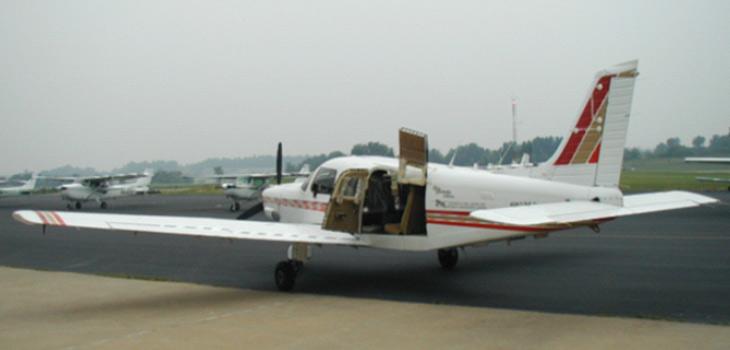
Piper Saratoga

The Avionics Engineering Center’s Piper Saratoga (N8238C) is a single engine, low-wing aircraft, which can seat up to six occupants. It is an excellent research platform due to its large cabin size and useful load.
Specifications
- Type: High performance single engine piston Piper Saratoga
- Year: 1980
- Engine: Lycoming IO-540, 300HP
- Seats: 6 including pilot
- Dimensions: Wingspan 36'2", Length 27'8", Height 8'2"
- Maximum takeoff weight: 3600 Lbs.
- Fuel capacity: 107 gallons
- Maximum speed: 227 mph.
- Cruise speed: 159 mph. at 8000' and 65% power
- Maximum altitude: ≈15,000'
- Maximum range: ≈900 nautical miles at 65% power
Research Equipment/Capabilities
- Equipment rack: 19" wide, 31.5" high, 23" deep
- Electrical power available:
- 50A @ 14VDC (power source for equipment and converters/inverters)
- 2.14A @ 115VAC, 60Hz
- 20A & 28VDC
Research Antennas Available
- Antcom G5Ant-3AT1 L1/L2 GPS, Glonass, OmniStar
- King KA-60 DME/Transponder (top and bottom of aircraft)
- AeroAntenna Technology AT130-1 UAT
- Dorne & Margolin DMN48-1 VOR/LOC
- VHF Com
- Comant CI-310-22 L-Band/UHF
- Additional 6.25"x5.75" research antenna patch panel on bottom of aircraft
Research Missions
The Saratoga has been used in many different AEC research missions:
- Microwave Landing System (MLS) / Mobile Microwave Landing System (MMLS) Tests
- Approach guidance and Curved approaches
- Curved missed-approach and departure evaluation flight tests
- MLS/ILS/GPS simultaneous data collection/characterization flights (ACY)
- Sector DME demonstration flight tests
- Low-power DME evaluation flight tests
- Safe-Flight 21 - ADS-B demonstration support and flight tests
- Oshkosh AirVenture - ADS-B target aircraft for Safe Flight 21/ UPS display
- Runway Incursion Reduction Program – flight and ground test aircraft
- LAAS DGPS VHF Data Broadcast measurement
- P-static testing for Loran-C navigation systems